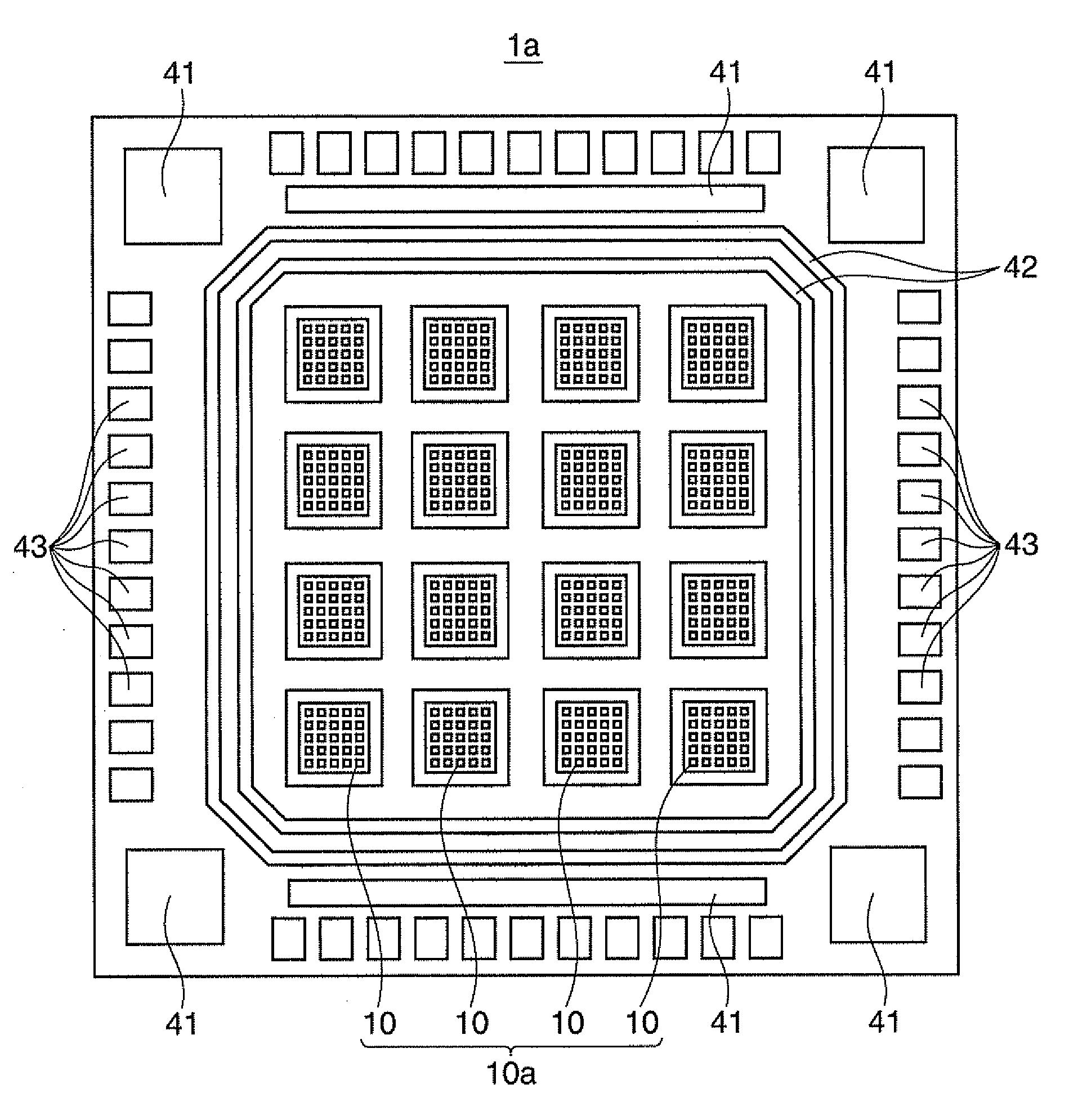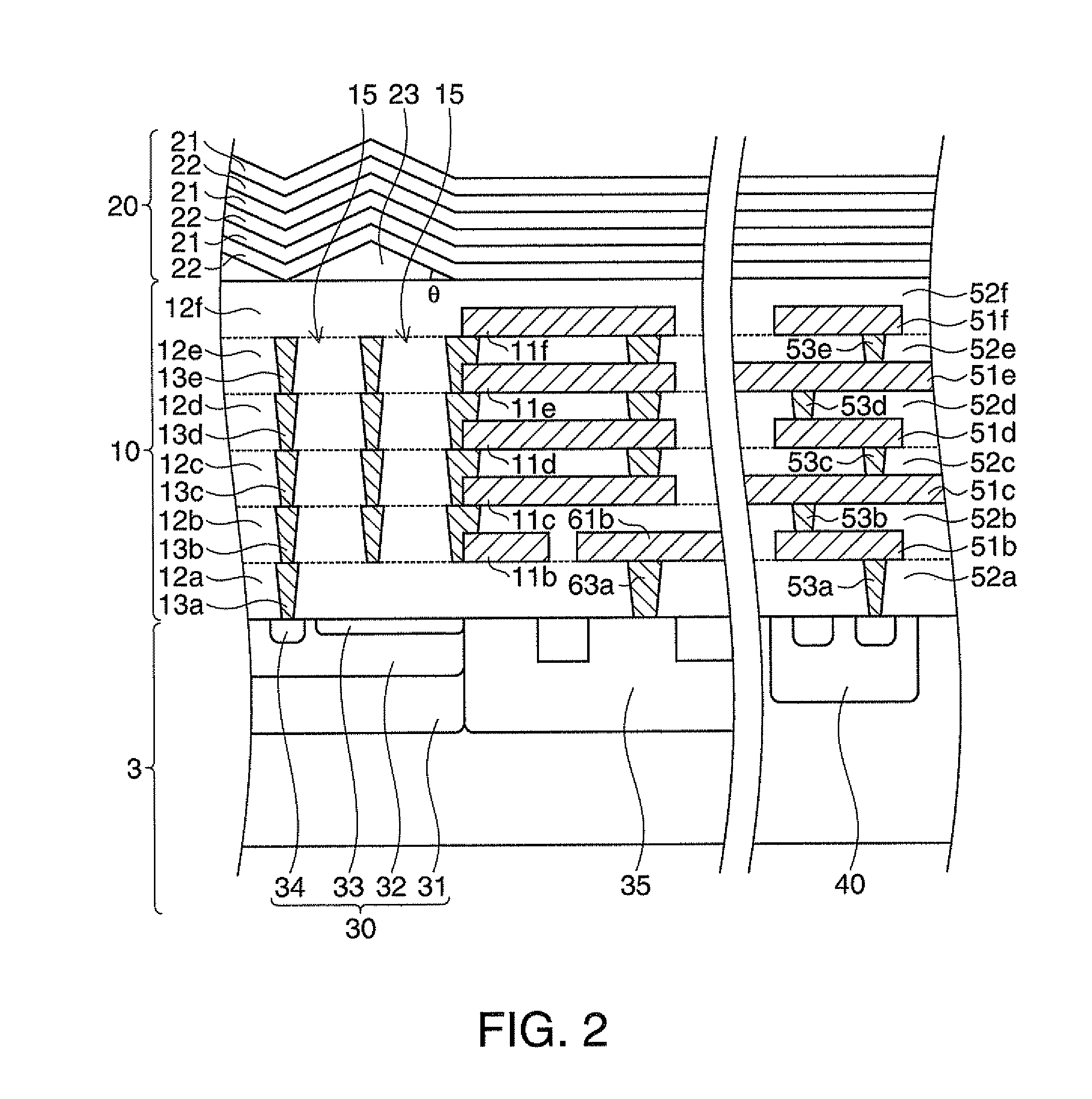Spectroscopic sensor and angle limiting filter
a technology of angle limitation and spectroscopic sensor, which is applied in the direction of spectrometry/spectrophotometry/monochromators, instruments, optical radiation measurement, etc., can solve the problem of difficult to reduce the size, difficult to install a number of sensors at desired places or constantly install sensors, and the possibility of making it difficult for light to have an incident angle exceeding the limited angular rang
- Summary
- Abstract
- Description
- Claims
- Application Information
AI Technical Summary
Benefits of technology
Problems solved by technology
Method used
Image
Examples
first embodiment
1. First Embodiment
[0034]FIGS. 1A and 1B are schematic views showing an angle limiting filter and a spectroscopic sensor according to a first embodiment of the invention. FIG. 1A is a plan view of the spectroscopic sensor. FIG. 1B is a cross-sectional view taken along line B-B of FIG. 1A, FIG. 2 is a cross-sectional view showing the angle limiting filter and the spectroscopic sensor according to the first embodiment. FIG. 2 corresponds to an enlarged view of a portion of surrounding line II shown in FIG. 1B.
[0035]The spectroscopic sensor 1 includes the angle limiting filter 10, a wavelength limiting filter 20, and a light receiving element 30 (refer to FIG. 1B). In FIG. 1A, the wavelength limiting filter 20 is not illustrated.
[0036]In a P-type silicon substrate 3 (refer to FIG. 2) as a semiconductor substrate on which the spectroscopic sensor 1 is formed, an electronic circuit including semiconductor elements 40 which apply a predetermined reverse bias voltage to the light receiving...
second embodiment
2. Second Embodiment
[0077]FIG. 4 is a cross-sectional view partially showing an angle limiting filter and wiring layers according to a second embodiment of the invention.
[0078]In the second embodiment, the thickness of the aluminum alloy layer 11e (and 11f) is greater compared to that of the aluminum alloy layers 11b to 11d. In such a case, for connecting the tungsten layer 13e with the tungsten layer 13d below the tungsten layer 13e when a groove is formed in the silicon oxide layer 12e to embed the tungsten layer 13e into the groove, it is necessary to make the groove formed in the silicon oxide layer 12e deep. However, if the etching time for the silicon oxide layers 12e and 52e is extended when the formation of groove in the silicon oxide layer 12e and the formation of groove in the silicon oxide layer 52e are performed in a common process, a titanium nitride (TiN) film on a surface of the aluminum alloy layer 51e is etched. Therefore, an electrical resistance between the alumin...
third embodiment
3. Third Embodiment
[0082]FIG. 5 is a cross-sectional view partially showing an angle limiting filter and wiring layers according to a third embodiment of the invention.
[0083]In the third embodiment, an aluminum alloy layer is not formed on the silicon oxide layer 12e and the uppermost tungsten layer 13e. In the first embodiment, since the aluminum alloy layer 11f is formed on the silicon oxide layer 12e and the tungsten layer 13e, and the silicon oxide layer 12f is further formed on the aluminum alloy layer 11f, it is necessary to planarize the silicon oxide layer 12f after depositing the silicon oxide layer 12f. In contrast to this, in the third embodiment, since an aluminum alloy layer is not formed on the silicon oxide layer 12e and the uppermost tungsten layer 13e, but the silicon oxide layer 12f is formed thereon, the silicon oxide layer 12f is evenly formed only by depositing the silicon oxide layer 12f. Accordingly, in the third embodiment, the process of planarizing the sili...
PUM
| Property | Measurement | Unit |
|---|---|---|
| refractive index | aaaaa | aaaaa |
| total thickness | aaaaa | aaaaa |
| length | aaaaa | aaaaa |
Abstract
Description
Claims
Application Information
 Login to View More
Login to View More - R&D
- Intellectual Property
- Life Sciences
- Materials
- Tech Scout
- Unparalleled Data Quality
- Higher Quality Content
- 60% Fewer Hallucinations
Browse by: Latest US Patents, China's latest patents, Technical Efficacy Thesaurus, Application Domain, Technology Topic, Popular Technical Reports.
© 2025 PatSnap. All rights reserved.Legal|Privacy policy|Modern Slavery Act Transparency Statement|Sitemap|About US| Contact US: help@patsnap.com



